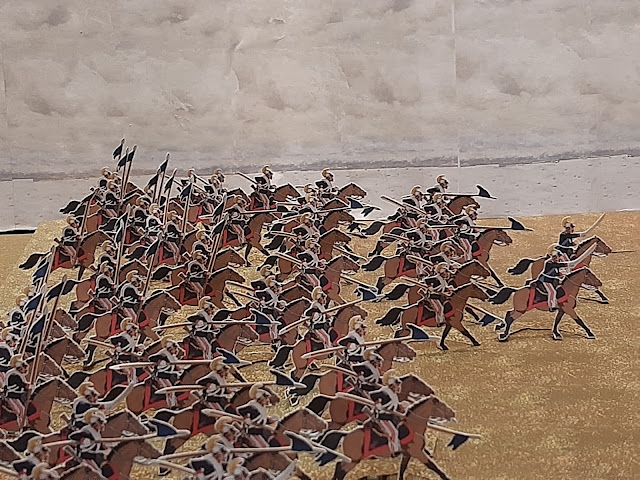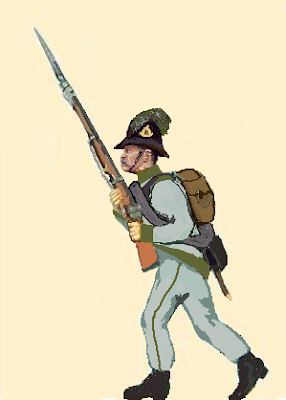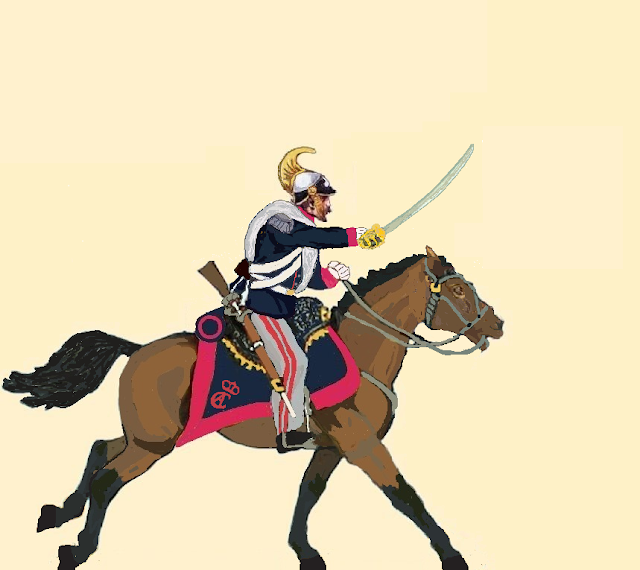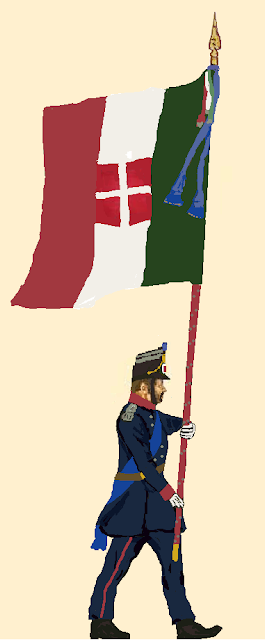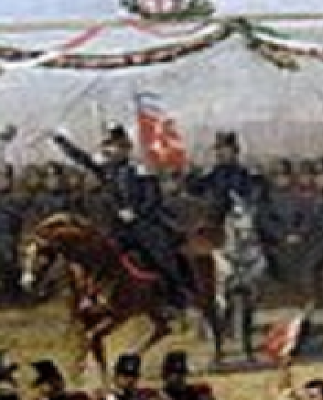Today this blog is 5 years old!. Happy birthday !
I have done some works on the "Alfiere" i.e. standard-bearer, of the Brigade AOSTA; actually the history of the Italian flag starts with the opening of the First Italian Indipendence War. The first colour was indeed a real motus of enthusiasm for the Italian cause that was also embraced by the King Carlo Alberto of Savoy.
After my researches I painted this 2 different poses of a standard-bearer of the Brigade Aosta; the first from a basis of a Russian Grenadier in winter coat of 1812 ... the second from another Russian 1812 figure.
1848 - Brigade Aosta - Standard-bearer
This officer (Leutenant) of the 5th Infantry Regiment of the Brigade AOSTA is carrying the first version of the Italian flag with at the center the Savoy (but also of Piedmont) coat of arms. The history of this flag is really very interesting.
The tricolor was a already consolidated tradition from the Napoleonic period, where the French simply substitued the blue of their flag with the green. Well the history is a little more complicated, but it is enough to say for now that the three colours - green, white and red - were considered already as the "Italian" colours, but also somehow rivolutionary and liberal colours.
In fact, in the Statute that Carlo Alberto of Savoy issued on 4th March 1848 (and that was valid untill 1946) it was stated that the colour of the Sardinian (Piedmontese) State was its flag that was this one:
(figure from "Uniformi Militari italiane dell'Ottocento dalla Restaurazione alla Unità Nazionale", Volune II, Part 1, by Valerio Gibellini - Rivista Militare)
So simply the Savoy coat of arms (and also of Piedmont); the Statute of 1848 then added that the cockarde would remain azure. Notwithstanding this, just few days later, on 25th March in Turin the King, on that very evening showed himself - under strong public pressure, but maybe also convinced of it - grabbing a green-white-red scarf. The same day the King did his proclame to the people of Lombardy and Venice where he stated that "to better show with external signs the feeling of the Italian union, we want the our troops, by entering in the territory of Lombardy of of the Venice - Venetian territory - carry the Savoy coat of arms over the Italian tricolor"
At this point of the history, came a certain Signor Bigotti, Secretary by Ministry of Internal Affairs, who was asked by the Board of Ministries to realize some sketches for the flag, according to the desire of the King. He was a good painter and he prepared 3 sketches (now all lost), but we still have their description, so I reproduced them:
All the Ministries chose the version 1, but at the monent some problem arose. The version 1 had the problem that the red of the coat of arms of Savoy could confuse with the red of the flag. Hence Signor Bigotti had the idea to add to the coat of arms of Savoy a blue (colour of the Savoy family) to the coat of arms, in this way
4th (and definitive) version of the Bigotti's flag.
During the process some Minister wanted the edge to be gold. Signor Biagiotti simply noted that the colour yellow would have been to similar to the Austrian flag, or at least it was not a colour to mention in the brand new flag. He then added: "let the azure edge wake in the souls the dear and glorious memory of the national colour, till then adopted by the Piedmontese Nation" Everyone accepted this suggestion (and still it has its followers, considersing that all the National Teams of Italy wear the azure colours, and are called "gli azzurri"). All the Ministries agreed.
So this sketch was presented to the King that at once approved it. The Regia Segreteria (Royal Secretary) gave immediate order to produce the maximim number of these flags to deliver to the Piedmontese troops that were entering Lombardy. Just it happened that in the confused process the original sketch went lost and the burocrats had to remember how it was the lost (and original) sketch. In particular, the confusion arose because already the evening of 25th March 1848 (the Piedmontese were and are very fast!) the Secretary sent a message (by horse) to the Governors of the Division in Alessandria and Novara stating that "all the troops had to have the Italian flag, white, red and green with in the centre the coat of Arms of Savoy (white cross on red field)".
1848 - Brigade AOSTA
Standard-bearer with flag with the Coat of Arms of Savoy edged in blue
(Copyright Michele L. SAVASTA FIORE)
So this dispatch didn't explain any measures, or shape and neither that the coat of arms should have the blue edge made a huge confusion; so at the very beginning the flag were of different dimensions, some with the edge, other without and so on.
There were - in the first phase of the conflict - 1 flag per battalion, i.e. 3 per regiment. Starting from 14th June 1848 the colours were reduced 1 per regiment.
In that period, were distributed 70 Italian flags to all the units, using the red flagpole model 1832, with azure scarfs (with in white the name and number of the regiment, see picture above); to these, usually were added 3 scarfs white green and red.
Then stating from Autumn 1848 the super picky Piedmontese administrative machine very precisely stated the shape, measurements of all flags, but for the moment I stop to the first part of the War, i.e until the defeat of Custoza the 25th July 1848, or even earlier to the Battle of Santa Lucia on 6th May 1848.
PS: all this news you will not find in the Osprey publishig. All what is said in Osprey Men at Arms nr. 512 is this (pag. 14):
I think this is the result when you want to shrink a huge history in some pages. I do like the series, but this time I was really disappointed.
So it also interesting to know that this speedy reform, done in few days, was in concrete carried out in April 1848. In fact, the Piedmontese Army, crossed the river Ticino, marking the border between the Kingdom of Sardinia and the Lombard-Venenetian Province of the Austrian Empire, still carried the "old" colours, issued in 1832, according to the desire of the King Carlo Alberto.
This fact is easly understandable, and also the sources of the epoch confirm this.
In the painting "Carlo Alberto greets the Piedmontese Troops crossing the River Ticino (on 29th March 1848, i.e. 4 days later than the order issued to change the colours of the Regimtn) it is clearly visible a standard that is not Italian, but Savoyard.
In fact, the Piedmontese Army had - till that very moment - a quite singular system of colours for its units.
There was a "Bandiera di Brigata" (Brigade colour), given to the 1st Battalion of the first Regiment of that Brigade.
1848. BRIGATA AOSTA
Bandiera di Brigata.
5th Regiment - 1st Battalion
(Source http://www.bandieresabaude.it/)
March 1848. BRIGATA AOSTA
Bandiera d'Ordinanza I Battalion of the 5th Regiment
(Copyright Michele L. SAVASTA FIORE)
Then there was the "Bandiera Reale" (Royal colour) that was similar to the Bandiera di Brigata, just without the Orders of Cavalry of the Savoy Family. It was given to the 1st Battalion of the 2nd REgiment of the Brigade.
1848. BRIGATA AOSTA
Bandiera Reale.
6th Regiment - 1st Battalion
(Source http://www.bandieresabaude.it/)
Not all first Battalions units had this Bandiera d'Ordinanza; the Regiment Cacciatori Guardia and the 2nd Regiment of the Savoia Brigade had the Savoy cross.
Then the second battalions of the 2 regiments forming the Birgade, had the same colours.
1848. BRIGATA AOSTA
Bandiera d'Ordinanza
5th and 6th Regiment - 2nd Battalions
(Source http://www.bandieresabaude.it/)
Not all second Battalions units had this Bandiera d'Ordinanza; Brigade Guardie and Brigade Savoia had the Savoy cross, visible in the next picture.
The third battallions of every regiment had the following colour:
1848. BRIGATA AOSTA
Bandiera d'Ordinanza III Battaglione
5th and 6th Regiment - 3rd Battalions
(Source http://www.bandieresabaude.it/)
This colour was also given -d ue to some refunishment problems - also to the second battallions of the following Regiments:
- Brigade Guardie (Grenadiers Regiment and Cacciatori Regiment)
- Brigade Savoia (both Regiments)
- Brigade Casale (the 12th Regiment)
- Brigade Pinerolo (the 14th Regiment)
- Brigade Savona (the 16th Regiment)
- Brigade Acqui (the 18th Regiment)
An example:
March 1848. BRIGATA AOSTA
Bandiera d'Ordinanza III Battalion of the 5th Regiment
(Copyright Michele L. SAVASTA FIORE)
This last colour is that visible in the painting above (see details), meaning that the troops entered in Lombardy on 29th March 1848 with their old flags. It was then issued to return them to the deposit in Piedmont and some of them went lost or captured during their travel back home.
Here a last example of Piedmontese standard-bearer
1848 - Brigade Aosta - Leutenenant Standard-bearer
Well I remade it with a more natural flag, at least, I hope so.
I decided to remake it different:
